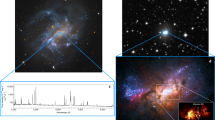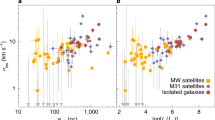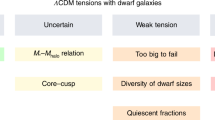Abstract
In the standard cosmological model, dark matter drives the structure formation of galaxies and constructs potential wells within which galaxies may form. The baryon fraction in dark halos can reach the Universal value (15.7%) in massive clusters and decreases rapidly as the mass of the system decreases1,2. The formation of dwarf galaxies is sensitive both to baryonic processes and the properties of dark matter owing to the shallow potential wells in which they form. In dwarf galaxies in the Local Group, dark matter dominates the mass content even within their optical-light half-radii (re ≈ 1 kpc)3,4. However, recently it has been argued that not all dwarf galaxies are dominated by dark matter5,6,7. Here we report 19 dwarf galaxies that could consist mainly of baryons up to radii well beyond re, at which point they are expected to be dominated by dark matter. Of these, 14 are isolated dwarf galaxies, free from the influence of nearby bright galaxies and high-density environments. This result provides observational evidence that could challenge the formation theory of low-mass galaxies within the framework of standard cosmology. Further observations, in particular deep imaging and spatially resolved kinematics, are needed to constrain the baryon fraction better in such galaxies.
This is a preview of subscription content, access via your institution
Access options
Access Nature and 54 other Nature Portfolio journals
Get Nature+, our best-value online-access subscription
$29.99 / 30 days
cancel any time
Subscribe to this journal
Receive 12 digital issues and online access to articles
$119.00 per year
only $9.92 per issue
Buy this article
- Purchase on Springer Link
- Instant access to full article PDF
Prices may be subject to local taxes which are calculated during checkout




Similar content being viewed by others
Data availability
The ALFALFA data are available in The Arecibo Legacy Fast ALFA Survey and the SDSS data are available at the Sloan Digital Sky Survey (http://egg.astro.cornell.edu/alfalfa/data/index.php, https://www.sdss.org/). The other data that support the results of this study are available from the corresponding author upon reasonable request.
Code availability
We use standard data reduction tools in the IDL and Python environments, and the publicly available code SExtractor (https://www.astromatic.net/software/sextractor) for this study.
References
White, S. D. M., Navarro, J. F., Evrard, A. E. & Frenk, C. S. The baryon content of galaxy clusters: a challenge to cosmological orthodoxy. Nature 366, 429–433 (1993).
Fukugita, M., Hogan, C. J. & Peebles, P. J. E. The cosmic baryon budget. Astrophys. J. 503, 518–530 (1998).
Walker, M. G. in Planets Stars and Stellar Systems Vol. 5 (eds Oswalt, T. D. & Gilmore, G.) 1039–1089 (2013).
Strigari, L. E. et al. A common mass scale for satellite galaxies of the Milky Way. Nature 454, 1096–1097 (2008).
van Dokkum, P. et al. A galaxy lacking dark matter. Nature 555, 629–632 (2018).
van Dokkum, P. et al. A second galaxy missing dark matter in the NGC 1052 group. Astrophys. J. 874, L5–L13 (2019).
Oman, A.-K. et al. Missing dark matter in dwarf galaxies? Mon. Not. R. Astron. Soc. 460, 3610 (2016).
Planck Collaboration Planck 2018 results. VI. Cosmological parameters. Preprint at http://arxiv.org/abs/1807.06209 (2018).
Simon, J. D. & Geha, M. The kinematics of the ultra-faint Milky Way satellites: solving the missing satellite problem. Astrophys. J. 670, 313–331 (2007).
Martin, N. F. et al. A Keck/DEIMOS spectroscopic survey of faint Galactic satellites: searching for the least massive dwarf galaxies. Mon. Not. R. Astron. Soc. 380, 281–300 (2007).
Sawala, T. et al. Bent by baryons: the low-mass galaxy-halo relation. Mon. Not. R. Astron. Soc. 448, 2941–2947 (2015).
Oh, S.-H. et al. High-resolution mass models of dwarf galaxies from LITTLE THINGS. Astron. J. 149, 180 (2015).
Bournaud, F. et al. Missing mass in collisional debris from galaxies. Science 316, 1166 (2007).
Fritz, T. K. et al. Gaia DR2 proper motions of dwarf galaxies within 420 kpc: orbits, Milky Way mass, tidal influences, planar alignments, and group infall. Astron. Astrophys. 619, 103–120 (2018).
Haynes, M. P. et al. The Arecibo Legacy Fast ALFA survey: the α.40 H i source catalog, its characteristics and their impact on the derivation of the H i mass function. Astron. J. 142, 170 (2011).
Abazajian, K. N. et al. The seventh data release of the Sloan Digital Sky Survey. Astrophys. J. Suppl. Ser. 182, 543–558 (2009).
Martin, D. C. et al. The Galaxy Evolution Explorer: a space ultraviolet survey mission. Astrophys. J. 619, L1–L6 (2005).
Lisker, T., Grebel, E. K., Binggeli, B. & Katharina, G. Virgo cluster early-type dwarf galaxies with the Sloan Digital Sky Survey. III. Subpopulations: distributions, shapes, origins. Astrophys. J. 660, 1186–1197 (2007).
Zheng, Z. et al. The structure and stellar content of the outer disks of galaxies: a new view from the Pan-STARRS1 medium deep survey. Astrophys. J. 800, 120 (2015).
Bell, E. F., McIntosh, D. H., Katz, N. & Weinberg, M. D. The optical and near-infrared properties of galaxies. I. Luminosity and stellar mass functions. Astrophys. J. Suppl. Ser. 149, 289–312 (2003).
Wang, J. et al. New lessons from the H i size-mass relation of galaxies. Mon. Not. R. Astron. Soc. 460, 2143–2151 (2016).
Navarro, J. F., Frenk, C. S. & White, S. D. M. A universal density profile from hierarchical clustering. Astrophys. J. 490, 493–508 (1997).
Burkert, A. The structure of dark matter halos in dwarf galaxies. Astrophys. J. 447, L25–L28 (1995).
Jing., Y. J. et al. Dark-matter-deficit galaxies in hydrodynamical simulations. Mon. Not. R. Astron. Soc. 488, 3298–3307 (2019).
Haslbauer, M. et al. Galaxies lacking dark matter in the Illustris simulation. Astron. Astrophys. 626, A47 (2019).
Hunter, D. A. et al. LITTLE THINGS. Astron. J. 144, 134 (2012).
Vogelsberger, M. et al. Introducing the Illustris project: simulating the coevolution of dark and visible matter in the Universe. Mon. Not. R. Astron. Soc. 444, 1518–1547 (2014).
Diaz-Garcia, S., Salo, H., Laurikainen, E. & Herrera-Endoqui, M. Astron. Astrophys. 587, A160–A220 (2016).
Giovanelli, R. et al. The Arecibo Legacy Fast ALFA survey. I. Science goals, survey design, and strategy. Astron. J. 130, 2598 (2005).
Giovanelli, R. ALFALFA: an exploration of the z = 0 H i universe. Il Nuovo Cim. B 122, 1097–1108 (2007).
Haynes, M. P. ALFALFA: the search for (almost) dark galaxies and their space distribution. Il Nuovo Cim. B 122, 1109–1114 (2007).
Giovanelli, R. et al. The Arecibo Legacy Fast ALFA survey. II. Results of precursor observations. Astron. J. 130, 2613 (2005).
Catinella, B. et al. The GALEX Arecibo SDSS survey. VI. Second data release and updated gas fraction scaling relations. Astron. Astrophys. 544, A65 (2012).
He, Y. Q. et al. Photometric properties and luminosity function of nearby massive early-type galaxies. Astrophys. J. 773, 37 (2013).
Liu, F. S., Xia, X. Y., Mao, S., Wu, H. & Deng, Z. G. Photometric properties and scaling relations of early-type brightest cluster galaxies. Mon. Not. R. Astron. Soc. 385, 23–29 (2008).
Du, Wei et al. Low surface brightness galaxies selected from the 40% sky area of the ALFALFA H i survey. I. Sample and statistical properties. Astron. J. 149, 199 (2015).
Alam, S. et al. The eleventh and twelfth data releases of the Sloan Digital Sky Survey: final data from SDSS-III. Astrophys. J. Suppl. Ser. 219, 12 (2015).
Bertin, E., Arnouts. SExtractor: software for source extraction. Astron. Astrophys. 117, 393–404 (1996).
Blanton, M. R. et al. The luminosity function of galaxies in SDSS commissioning data. Astron. J. 121, 2358–2380 (2001).
Yasuda, N. et al. Galaxy number counts from the Sloan Digital Sky Survey commissioning data. Astron. J. 122, 1104–1124 (2001).
Roberts, M. S. The neutral hydrogen content of late-type spiral galaxies. Astron. J. 67, 437–446 (1962).
Masters, K. L. Galaxy flows in and around the Local Supercluster. PhD dissertation, Cornell Univ. AAT 3192074 (2005).
Kroupa, P. The initial mass function of stars: evidence for uniformity in variable systems. Science 295, 82–91 (2002).
Giovanelli, R. et al. The I band Tully-Fisher relation for cluster galaxies: data presentation. Astron. J. 113, 22–52 (1997).
Tully, B. R. et al. The extragalactic distance database. Astron. J. 138, 323–331 (2009).
Starkenburg, S. et al. On the origin of star-gas counterrotation in low-mass galaxies. Astrophys. J. 878, 143–155 (2019).
Dutton, A. A. & Macciò, A. V. Cold dark matter haloes in the Planck era: evolution of structural parameters for Einasto and NFW profiles. Mon. Not. R. Astron. Soc. 441, 3359–3374 (2014).
Salucci, P. et al. The universal rotation curve of spiral galaxies—II. The dark matter distribution out to the virial radius. Mon. Not. R. Astron. Soc. 378, 41–44 (2007).
Huchra, J. P. et al. The 2MASS Redshift Survey—description and data release. Astrophys. J. Suppl. Ser. 199, 26 (2012).
Saulder, C., van Kampen, E., Chilingarian, I., Mieske, S. & Zeilinger, W. W. The matter distribution in the local Universe as derived from galaxy groups in SDSS DR12 and 2MRS. Astron. Astrophys. 596, A14 (2016).
Guo, Qi et al. From dwarf spheroidals to cD galaxies: simulating the galaxy population in a ΛCDM cosmology. Mon. Not. R. Astron. Soc. 413, 101–131 (2011).
Guo, Qi et al. Galaxy formation in WMAP1 and WMAP7 cosmologies. Mon. Not. R. Astron. Soc. 428, 1351–1365 (2013).
Blanton, M. R., Geha, M. & West, A. A. Testing cold dark matter with the low-mass Tully-Fisher relation. Astrophys. J. 682, 861–873 (2008).
Springob, C. M., Haynes, M. P., Giovanelli, R. & Kent, B. R. A digital archive of H i 21 centimeter line spectra of optically targeted galaxies. Astrophys. J. Suppl. Ser. 160, 149–162 (2005).
Rines, K., Geller, M., Kurtz, M. & Diaferio, A. CAIRNS: the cluster and infall region nearby survey. I. Redshifts and mass profiles. Astron. J. 126, 2152–2170 (2003).
Acknowledgements
This work is supported by the National Key R&D Program of China (grant number 2018YFA0404503, 2016YFA0400703 and 2016YFA0400702), the National Natural Science Foundation of China (grant numbers 11573033, 11622325, 11133003, 11425312, 11773001, 11721303, 11733006 and 11703036) and the National Natural Science Foundation of China (grant numbers 11573033, 11622325, 11133003, 11425312, 11773001, 11721303, 11733006, 11703036 and U1931110). Q.G. and L.G. acknowledge support from Royal Society Newton Advanced Fellowships. Z.Z. acknowledges the support by the Open Project Program of the Key Laboratory of FAST, Chinese Academy of Sciences.
Author information
Authors and Affiliations
Contributions
Q.G. led and played a part in all aspects of the analysis, and wrote the manuscript. H.H. compiled the data and carried out most of the data reduction and analysis. Z.Z. measured the optical photometry of the low-surface-brightness galaxy. SH.L. carried out most of the analysis related to various mass determinations. All authors contributed to the analysis and to the writing of the manuscript.
Corresponding author
Ethics declarations
Competing interests
The authors declare no competing interests.
Additional information
Publisher’s note Springer Nature remains neutral with regard to jurisdictional claims in published maps and institutional affiliations.
Extended data
Extended Data Fig. 1 Comparison of the galaxy properties between different methods for dwarf galaxies in LITTLE THINGS.
a, Comparison of the rH i using our method with that obtained using tilted-ring method by LITTLE THINGS team. b, Comparison of the VH i using our method with that obtained using tilted-ring method by LITTLE THINGS team. c, Comparison of the dynamical mass estimated using our method with those derived using the tilted-ring method. Black and grey dots are measurements based on w20 and w50, respectively.
Extended Data 2 Distribution of the Mdyn-to-Mbary ratio with different misalignments between optical image and H i velocity field.
a, The distribution of the misalignment between optical image and H i velocity field for dwarf galaxies in LITTLE THINGS(red)/Illustris(cyan). b,c, Distribution of the Mdyn/Mbary ratio for our parent sample after applying the same distribution of misalignment between optical image and H i velocity field from the LITTLE THINGS/Illustris in the left panel. Grey histogram is based on 10,000 random realizations and black curve is the Gaussian fit. Samples classified as BDDGs are highlighted with blue histogram.
Extended Data 3 Comparison of rH i and re between the parent sample and the BDDGs.
a, rH i and re relation of the parent sample (black dots) and the BDDGs (blue dots). b, The distribution of rH i, grey histogram and blue histogram represent the parent sample and BDDGs respectively. c, The distribution of re, grey histogram and blue histogram represent parent sample and BDDGs respectively.
Extended Data Fig. 4
BDDGs data. Column 1 shows the ALFALFA galaxy ID; columns 2 and 3 show equatorial coordinates; column 4 shows the distance judged by ALFALFA group; column 5 shows the heliocentric velocity; column 6 shows the velocity width for 20% of the peak flux; column 7 shows the error of w20; columns 8 and 9 show the g-band and r-band magnitudes, respectively; column 10 shows the effective radius in the r-band; column 11 shows the neutral hydrogen mass; column 12 shows the stellar mass; column 13 shows the dynamical mass within rH i; column 14 shows the virial mass; column15 shows the r-band minor-to-major axis ratio; and column 16 shows the distance to the nearest group over virial radius.
*In the literature AGC 6980 was defined as Abell 1367’s member (Leo cluster: \({\mathrm{c}}z = 6459\), RA = 176.15083, Dec. = 19.77194)55. The projected distance between the AGC 6980 and Abell 1367 is about 8 Mpc, well beyond 3Rvir of the Abell 1367. †The minimum projected distance of the BDDG to its surrounding clusters with relatively small difference in redshifts (czBDDG – czcluster < 10 × Rcluster;vir) is <3 × Rvir.
Rights and permissions
About this article
Cite this article
Guo, Q., Hu, H., Zheng, Z. et al. Further evidence for a population of dark-matter-deficient dwarf galaxies. Nat Astron 4, 246–251 (2020). https://doi.org/10.1038/s41550-019-0930-9
Received:
Accepted:
Published:
Issue Date:
DOI: https://doi.org/10.1038/s41550-019-0930-9
This article is cited by
-
Galaxies lacking dark matter produced by close encounters in a cosmological simulation
Nature Astronomy (2022)



